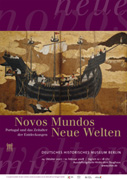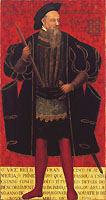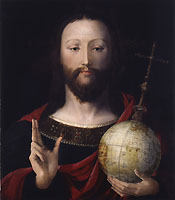


Prologue
| Portugal in the Middle Ages
| Conditions at the Start
| Voyages of Discovery
Cartography and Nautics
| New Worlds – Old Empires
| Portugal Overseas
| Art and Curiosity Cabinets
Portugal in the 16th Century
| International Conflicts
| Foreign Images
1. The Estado da Índia
In the 16th century Portugal established a network of strategically important trade and military posts around the Indian Ocean, forming a colonial empire of global dimensions. The Estado da Índia (Portuguese India) comprised an area reaching from eastern Africa across India and South East Asia to Japan.
The Estado dominated the highly profitable spice trade for which the Portuguese crown claimed a far-reaching monopoly. Portugal gained control over the South East Asian trading area by capturing the port city of Malacca on the Malay Peninsula. This gave them access to the coveted Spice Islands as well as the sandalwood island of Timor and the western Pacific. Portuguese ships supplied the European market above all with pepper, cinnamon, cloves and nutmeg. The handling of the merchandise traffic of silk for silver between China and Japan also proved highly lucrative.
Parallel to these trading activities, the Portuguese in Brazil established a flourishing trade in wood and sugar with Europe. Numerous slaves from western Africa were carried off to America to operate the profitable sugar plantations and mills.

Francisco de Almeida, der erste portugiesische Vizekönig in Indien
Lissabon, Museu Nacional de Arte Antiga

Der Markt von Goa, in: Jan Huygen van Linschoten, Histoire de la Navegation, Amsterdam 1638
Lissabon, Sociedade de Geografia
2.Missionary Work
The Iberian voyages of discovery are closely connected with the worldwide spread of the Catholic faith. In papal bulls of the 15th century the “new” territories were declared the rightful possession of Portugal or Spain. Through the Order of Christ, Portugal was awarded the patronage of the Church. It was thus obliged to spread Christianity, build churches and support church representatives in its overseas territories. In return Portugal was allowed to choose the clerical personnel in its territories, to present suggestions for new bishoprics and to collect tithes.
The religious orders such as the Franciscans, Dominicans and, after 1540, the Jesuits played a major role in the missionary work in the overseas territories. Besides their religious ambitions they marked the image of Europe abroad through their political activities as well as their scientific undertakings. Their missionary work and struggle against indigenous religious beliefs often led to an increase in tension and conflicts.

Salvator mundi - Christus mit der Weltkugel, Niederrhein, 1537/1545
Berlin, Deutsches Historisches Museum

Der Heilige Franz Xaver, Japan ?,
um 1600,
Lissabon, Santa Casa da Misericórdia de Lisboa / Museu de São Roque
